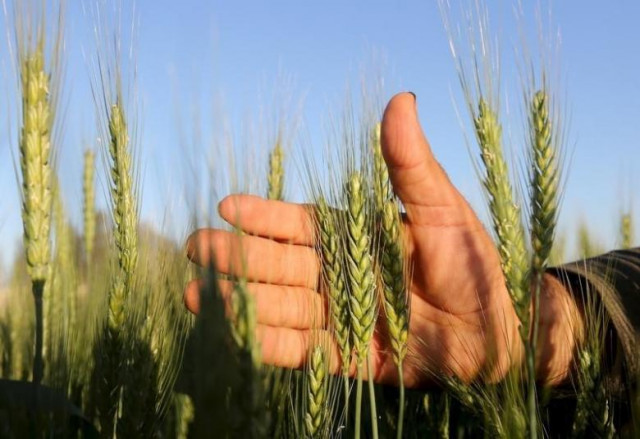Pakistan's wheat production likely to hit five-year low
Output may be 24.8m tons against target of 25.6m tons as cultivated area shrinks

Representational image. PHOTO: REUTERS
The country is likely to produce 24.8 million tons of wheat in the current crop year, which is a five-year low, if farmers manage to take per-acre production to the level of 2,885 kg they achieved in the previous year, according to the State Bank of Pakistan’s (SBP) second quarterly report on the state of economy.
The chances of matching last year’s per-acre production are low for the reasons that Sindh, which has the highest per-acre production in the country, has cultivated the crop over a lower area and the farmers reduced the quantity of essential di-ammonium phosphate (DAP) fertiliser and other nutrients during sowing.
Accordingly, this will be the second successive year in which wheat production in the country is set to be lower than the preceding year. More importantly, the anticipated production is most likely to drop to a five-year low.
The low production is, however, not a threat to food security as the county has a notable carryover stock of wheat following surplus crops in the past two successive years, according to the central bank.
The low wheat production will, however, contribute to a slowdown in the real economic growth in the country. Apart from this, the low harvests of all three major summer crops, including cotton, rice and sugarcane, have already impacted the gross domestic product (GDP) growth.
The SBP said second estimates of major Kharif (summer) crops reinforced the earlier assessment of lower production levels for all the three major crops in FY19 compared to FY18 - cotton harvest will go down by 9.2%, rice 3.9% and sugarcane 15.9%.
“While rice and sugarcane surpassed the targets set in the Annual Plan FY19, the fall from last year’s level will weigh heavily on growth of the crop sector,” it said.
“After Kharif, when farmers faced water shortage, the situation became more acute in initial months of the Rabi (winter) season. In addition to water scarcity, fertiliser offtake declined and credit flow decelerated during the wheat sowing months.”
Area under wheat cultivation is estimated to shrink 2.9%. “Most of this fall in area has been recorded in Sindh, which has the highest average yield among provinces,” the central bank said.
Challenges regarding canal water availability persisted in the sowing months of Rabi (winter) season as irrigation flows stood at 16 million acre feet (MAF) in the second quarter of FY19, not only 6.3% lower than the previous year but also lower than the Q2 average over the last five years, it said.
“The decline in fertiliser usage is more pronounced than the reduction in area under wheat cultivation. It is mainly explained by an increase of 16.7% in fertiliser prices. Furthermore, the fall in DAP offtake, the essential imported fertiliser used during sowing, was more pronounced as its price increase (around 30% in Q2) was due to a combination of rise in international prices and rupee depreciation,” the report said.
“In the presence of significant carryover stocks, the government had reduced the target for the planted area.”
Published in The Express Tribune, March 28th, 2019.
Like Business on Facebook, follow @TribuneBiz on Twitter to stay informed and join in the conversation.



















COMMENTS
Comments are moderated and generally will be posted if they are on-topic and not abusive.
For more information, please see our Comments FAQ